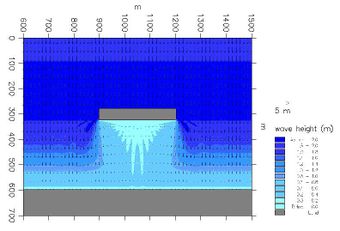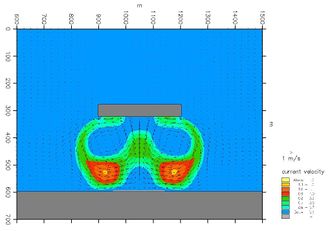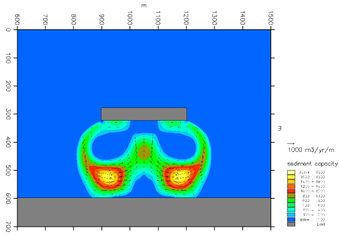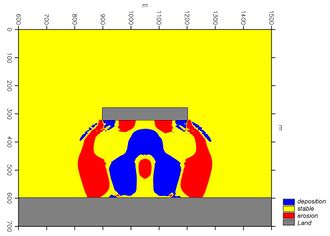Difference between revisions of "Detached breakwaters"
(→Definition) |
|||
| Line 2: | Line 2: | ||
==Definition== | ==Definition== | ||
| − | + | {{Definition|title=Detached breakwater | |
| − | + | |Definition= | |
| − | + | a structure parallel, or close to parallel, to the coast, built inside or outside the surf-zone. Detached breakwaters are mainly built with two purposes, either to protect a ship wharf from wave action or as a coast/shore protection measure. | |
| − | + | }} | |
==Variable of breakwater schemes== | ==Variable of breakwater schemes== | ||
Revision as of 09:05, 25 January 2007
Detached breakwaters are used as shore and coast protection measures. In general terms, a detached breakwater is a coast-parallel structure located inside or close to the surf-zone.
Contents
Definition
Definition of Detached breakwater:
{{{definition}}}
This is the common definition for Detached breakwater, other definitions can be discussed in the article
|
Variable of breakwater schemes
Breakwater schemes have many variables, which determine the impact on the shoreline. The variable parameters are outlined in the following:
- Emerged, submerged or floating
- Distance from shoreline and location relative to the surf-zone
- Length and orientation
- Single or segmented
- Special shapes
A complete description of combinations of all these parameters falls outside the scope of this section but there are further descriptions in (LINK: section 12).
Purpose of a breakwater
A shoreline management breakwater serves two purposes:
- To provide shelter from the waves
- Through this shelter, to manipulate the littoral transport conditions and thereby to trap some sand
Some breakwaters, offshore breakwaters, are constructed in deep water as a special type of port, providing shelter for a piled berth connected to the coast by a piled jetty. This kind of port is normally used when the slope of the coastal profile is very gentle, which makes the construction of a traditional port very costly. The philosophy is that the distance to the shoreline behind this kind of port will minimise the impact on the shoreline. However, in practice, it is very difficult to construct such a zero impact port.
Hydrodynamic impacts
A detached breakwater has the following impact on the hydrodynamic conditions in the adjacent area:
- The breakwater shelters partly from the waves; however, as the waves diffract into the sheltered area, a complete shelter cannot be obtained. The longer the breakwater, the better the shelter. Submerged and floating breakwaters provide less shelter.
- Wave-overtopping of submerged or low breakwaters will cause an additional supply of water in the area behind the breakwater, and consequently some compensation currents running out the sheltered area.
- The wave set-up on the foreshore is less in the sheltered area than outside, which generates local currents towards the sheltered area along the foreshore from both sides of the breakwater so that two eddies develop. These eddies also develop in the case of oblique wave approach.
- The longshore current is partially blocked by the circulation currents; this causes some of the longshore currents to be diverted outside the breakwater.
- Image: Wave and current conditions at a detached breakwater with a perpendicular wave approach.
Morphological impact
And the following impact on the morphological conditions:
- The littoral transport in lee of the breakwater decreases due to the attenuated wave and longshore currents in the area sheltered by the breakwater. This causes the trapping of sand behind the breakwater depending on the conditions. As a rule-of- thumb, the trapping of sand will develop into a tombolo formation connecting the breakwater and the shore by sand deposits, if the length of the breakwater is equal to or longer than 0.8 times the distance between the shore and the breakwater. For shorter breakwaters, only a salient in the shoreline will develop.
- The diversion of the longshore currents will cause the development of local erosion close to the heads of the breakwater.
- The trapping of sand, especially if a tombolo has developed, will cause lee side erosion downstream of the breakwater. This downstream erosion is very similar to what is developed for groynes. However, there are more parameters involved in breakwaters, so it is possible to manipulate the transport in a more refined manner.
- A breakwater traps sand under all circumstances, even if the net transport is zero. This means also that there will be a coastal impact in any case.
- Image: Initial sediment transport pattern and initial morphological impact caused by a detached breakwater for perpendicular wave approach.
When several breakwaters are constructed in a row, the system is referred to as a segmented breakwater. A segmented breakwater is used to protect long sections of shoreline; the downstream coastal impact will be correspondingly larger than for a single breakwater.
Other imapcts
Other impacts by breakwaters:
- If segmented breakwaters are constructed with too small gaps, the water exchange in the embayments between the breakwaters may be poor.
- Breakwaters normally obstruct part of the view over the sea, which means that the visual impact can be unacceptable.
- Swimmers may feel tempted to use the sheltered area in connection with detached breakwaters, but the circulation currents can be dangerous.
Temp
References
Author: Karsten Mangor, DHI, 2004. km@dhi.dk.



